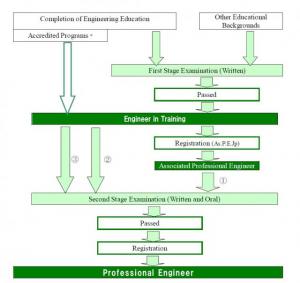ホーム![]() HOME in English
HOME in English![]() Assessment Mechanisms for PE.Jp
Assessment Mechanisms for PE.Jp![]() Domestic Assessment Mechanism
Domestic Assessment Mechanism

Domestic Assessment Mechanism
Domestic Assessment Mechanism
Written and Oral Examinations are applied to assess whether an engineer who wishes to become P.E.Jp has professional competence required to be qualified as P.E.Jp. The Professional Engineer Examination has been composed of the First-stage Professional Engineer Examination (hereinafter referred to as “1st-stage PE Exam”) and the Second-Stage Professional Engineer Examination (hereinafter referred to as “2nd-stage PE Exam”), and these examinations are implemented for each technical discipline. An engineer who has passed 1st-stage PE Exam is qualified to be As. P.E.Jp (Associate Professional Engineer, Japan). An engineer who has passed 2nd- stage PE Exam is qualified to be P.E.Jp. All applicants who take 2nd-stage PE Exam shall have passed 1st-stage PE Exam and shall have practical experience of a minimum of seven years after graduation from an engineering course (four years in case of assisting work of P.E.Jp as As.P.E.Jp and four years in case of engineering working after passing 1st-stage PE Exam under the supervision of experienced engineers). For postgraduates a maximum of 2 years in a graduate school could be counted as practical experience in the required experience years. The PE Act allows applicants who completed an engineering program accredited by JABEE (Japan Accreditation Board for Engineering Education) to be exempted from 1st-stage PE Exam.
Notes:
- Minimum four years of practical experience of assisting work of P.E.Jp as As.P.E.Jp.
- Minimum four years of practical experience after passing 1st-PE Exam under the
supervision of an instructing engineer who has a minimum seven years of practical
experience of engineering work. - Minimum seven years of practical experience
* Accredited programs: The programs accredited by JABEE. MEXT (Ministry of Education, Culture, Sports, Science and Technology) notifies those accredited programs through official gazettes.?
Inquiry:Secretariat Phone:+81-3-3459-1331
「IPEJ」,「日本技術士会」,「技術士会」,「CEマーク」及び「PEマーク」は、公益社団法人日本技術士会の登録商標です。
公益社団法人 日本技術士会 / Copyright IPEJ. All Rights Reserved.


